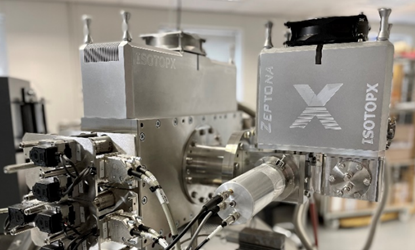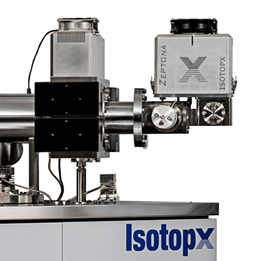If you work in isotope ratio mass spectrometry you probably already know about ATONA, the revolutionary Faraday detector technology. And if you don’t, you should! You can click here to read the basics.
In brief, ATONA is a Faraday amplifier system that avoids many of the major disadvantages of traditional resistor-based amplifier systems, in particular avoiding the usage challenges of the higher-resistance (1e12 and 1e13 Ohm) systems.
I follow isotope ratio technology developments avidly so have been keen to learn more about ATONA, it’s capabilities and its limitations. One thing in particular warranted investigation: how low can you go? In other words, when does the ion beam size become too low to measure on an ATONA-equipped system, necessitating ion counting? And also, what does Zeptona bring to the party? Let’s take a look…
If you have comments, thoughts, or corrections, do please feel free to contact me directly, I’d love to hear from you (stephen.guilfoyle@isotopx.com).

Fortunately, there are publications from ATONA users, and some of them have had the same idea –compare ATONA’s capabilities to other commercially-available detection systems. Possibly the most in-depth analysis so far is the one from Szymanowski and Schoene (Link to publication, you’ll need to pay unless you have academic access).
What follows are my personal thoughts and interpretations of the contents of the paper. I think it’s an excellently written and scientifically thorough article, but don’t take my word for it, read the paper yourself and make your own mind up.

What’s it about?
This paper evaluates the performance of ATONA amplifiers on the Phoenix TIMS at Princeton University and gauges their suitability for U-Pb geochronology. The authors describe the limitations of the current technique, i.e. the use of a single ion counter requiring peak-hopping routines with subsequent analysis times of 2-5 hours per sample. They discuss the increased use of high-ohmic resistors in Faraday amplification and detail the limitations of these, particularly due to dynamic range. The authors measure both standards and zircon samples and compare the data to that routinely achieved using traditional resistive Faraday amplifiers They use this data to identify the sample sizes / ion beam currents where ATONA can offer analytical benefits vs ion counting techniques.
What experimental work was done?
The sample preparation is described in detail. The Phoenix TIMS used for measurements is equipped with nine Faraday detectors and a single Daly ion counting detector. Data was acquired statically using solely the Faraday detectors or either using a combination of Faradays and the Daly (FaraDaly) or just the Daly. A range of sample sizes were measured, and a range of analytical conditions was explored, including baseline length and integration time.
What did the authors find?
Baseline and noise
The authors found that the noise levels for the ATONA system were extremely low, approaching the theoretical limit for 10e13 ohm resistors for 100s integration times. They state that these noise levels should allow quantification of beams as small as 10 aA (60 cps) with a signal to noise ratio of 10. Both baselines and noise were found to be remarkably stable, even over nine months of use. Furthermore, they believe this means that block-by-block baseline measurements are not required, significantly reducing total analysis time compared to other TIMS instruments.
Gain stability
The authors performed gain calibrations over the course of nine months and observed excellent reproducibility, with single-channel values of about 0.6ppm (1 SD). This is far better than values typically observed with high-ohmic resistor systems, in fact the authors recommend a gain calibration is only required on a weekly or monthly basis. This nicely echoes our own experiences at Isotopx.
Response time
The authors observed an extremely fast response time (<5ppm of beam intensity after 0.5 seconds) and state that it is a key advantage over 10e13 ohm amplifiers, significantly reducing analysis time.
Pb analysis
Comparing ATONA Faraday to Daly-only measurements, the authors saw that the ATONA Faraday-only measurements outperformed the Daly-only measurements for all measurements where the limiting (smallest) beam was >1mv. They state that Phoenix with ATONA is ideally suited to Pb analysis of samples with >10pg of radiogenic lead.
A second important finding was that the ATONA setup (FaraDaly for Pb + Faraday for UO2) was able to generate accurate and precise data for both synthetic zircon-like U-Pb solutions and standard zircons of known age. Other than the smallest samples that ran at <1 mV Pb (as mentioned above), those data were accurate and mostly acquired in a significantly shorter amount of time than done until now.
Summary
They summarize that Phoenix with ATONA is ideally suited to Pb analysis of samples with >10pg of radiogenic lead. My closing comment about this publication is a direct quote: “For practical purposes, the advantages of using the ATONA for U–Pb geochronology are similar to those of 10e13 ohm amplifiers, but with a greater degree of flexibility in cup configuration, shorter response time, larger dynamic range and better gain stability.” I couldn’t agree more!
And what of Zeptona?

Szymanowski and Schoene’s findings were that an ATONA Faraday-only or FaraDaly system produces better data than an ion counting system for beams about 1 mv in size for the smallest isotope measured. So how do we do even better than this? Zeptona takes the ATONA system and supercharges it. It’s a custom designed single Faraday detector that sits behind the main collector array of Phoenix TIMS. This set-up allows for even lower noise characteristics than ATONA, typically five times lower than ATONA and comparable to a theoretical 1e14 ohm resistor for typical integration times. You can read more about Zeptona here.

Reference: S. Richter. Goldberg,S.A, Mason, P.B., Traina, A.J. Schweiters, J.B. 2001. Linearity tests for secondary electron multipliers used in isotope ratio mass spectrometry. International. Journal of Mass Spectrometry. 206. 105-127
So Zeptona offers a significant step up in performance compared to ATONA. And as it’s fitted behind the main collector block, Zeptona can also be fitted with a WARP filter for improved abundance sensitivity. It’s pretty easy to imagine the applications for it.
I hope this has been an informative quick look at ATONA and the capabilities it offers. Contact the team at Isotopx if you have comments about this post or want to learn more.
